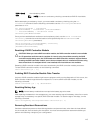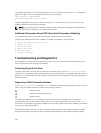
If you take a RAID controller module offline, the second RAID controller module in the pair takes over.
Disk groups and their associated virtual disks that were assigned to the offline RAID controller module are
automatically reassigned to the remaining RAID controller module.
CAUTION: Place a RAID controller module in Service mode only under the direction of Technical
Support.
Use Service mode when you want to perform an operation, such as replacing a RAID controller module.
Placing a RAID controller module in Service mode makes it unavailable for I/O operations. Placing a RAID
controller module in Service mode also moves the disk groups from the RAID controller module to the
second RAID controller module without affecting the disk groups’ preferred path. Moving disk groups
might significantly reduce performance. The disk groups are automatically transferred back to the
preferred RAID controller module when it is placed back online.
CAUTION: A multipath driver is required on all hosts and is the only supported configuration. If
the multipath driver is not installed, the virtual disks are not accessible.
Before you place a RAID controller module in Service mode, ensure that a multipath driver is installed on
all hosts using these virtual disks.
To change the operational mode of a RAID controller module, run the following command:
set controller [(0 | 1)] availability=(online | offline | serviceMode)
Changing RAID Controller Module Ownership
You can change which RAID controller module owns a virtual disk by using the set virtualDisk
command. The following syntax is the general form of the command:
set (allVirtualDisks | virtualDisk
[virtualDiskName] | virtualDisks [virtualDiskName1
... virtualDiskNameN] | virtualDisk <wwid> owner=(0 | 1)
Initializing A Physical Disk
CAUTION: When you initialize a physical disk, all data on the physical disk is lost.
You must initialize a physical disk when you have moved physical disks that were previously part of a disk
group from one storage array to another. If you do not move the entire set of physical disks, the disk
group and virtual disk information on the physical disks that you move is incomplete. Each physical disk
that you move contains only part of the information defined for the virtual disk and disk group. To be able
to reuse the physical disks to create a new disk group and virtual disk, you must erase all old information
from the physical disks by initializing the physical disk.
When you initialize a physical disk, all old disk group and virtual disk information is erased, and the
physical disk is returned to an unassigned state. Returning a physical disk to an unassigned state adds
unconfigured capacity to a storage array. You can use this capacity to create additional disk groups and
virtual disks.
To initialize a physical disk, run the following command:
start physicalDisk [enclosureID,slotID] initialize
where, enclosureID and slotID are the identifiers for the physical disk.
120


















